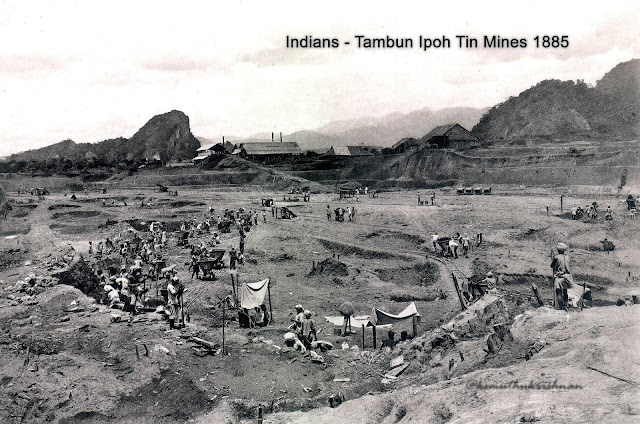மலாயா ரப்பர் தோட்டங்களில் மட்டும் மலாயா தமிழர்கள் வேலை செய்யவில்லை. பல நூறு பல ஆயிரம் தமிழர்கள், மலாயா ஈயச் சுரங்கங்களில் வேலை செய்து இருக்கிறார்கள். பலருக்கும் தெரியாத அரிய தகவல்.
Malaya Tamils did not only worked in Malaya rubber plantations; but hundreds and maybe thousands worked in the tin mines in this country. This is a rare information unknown to many.
1830 – 1840-ஆம் ஆண்டுகளில் ஈப்போவில் ஈய உற்பத்தி அபரிமிதமான வளர்ச்சி. அந்தி மந்தாரத்துக் காளான்கள் போல நிறைய ஈயச் சுரங்கங்கள் தோன்றின. அந்தச் சுரங்களுக்கு ஆயிரக் கணக்கில் சீனர்கள் கொண்டு வரப் பட்டனர். சீனர்களுடன் தமிழர்களும் கொண்டு வரப் பட்டனர்.
During the 1830s and 1840s there was an excessive tin production in Ipoh. Lots of tin mines appeared like twilight mushrooms. Thousands of Chinese were brought to the mines. Tamils were brought along with the Chinese.
ஜேம்ஸ் பர்ச் (J.W.W Birch) பேராக் மாநிலத்தின் முதல் பிரிட்டிஷ் ஆளுநர். 1875-ஆம் ஆண்டு பேராக் மாநில வருவாயை அதிகரிக்க ஈயச் சுரங்க முதலாளிகளிடம் வரி வசூல் செய்வதை நிறுத்தினார். அதனால் ஈயத் தொழில் வளர்ச்சி கண்டது. இவர் அதே 1875-ஆம் ஆண்டு பாசீர் சாலாக் எனும் இடத்தில் கொலை செய்யப்பட்டார். பலருக்கும் தெரியும். இதனால் ‘பேராக் போர்’ தொடங்கியது. (Khoo & Lubis 2005)
J.W.W Birch was appointed the first British Resident in Perak in 1875. He then planned
to get rid of the tax upon the tin miners to increase state revenue. (Khoo & Lubis 2005). In November 1875, Birch was murdered in Pasir Salak, Perak and this incident was reffered to by British as the ‘Perak War’.
ஈப்போ, கோப்பேங், துரோனோ, கோலாகங்சார், தைப்பிங் போன்ற பகுதிகளில் தமிழர்களின் ஈயச் சுரங்க ஈடுபாடுகள் நிறையவே இருந்து உள்ளன. ஆக ரப்பர் தோட்டங்கள் ஒரு புறம் இருந்தாலும், ஈயச் சுரங்கங்களிலும் தமிழர்களின் ஈடுபாடுகள் இருந்து உள்ளன.
Tamils involved in many tin mining activities in Ipoh, Gopeng, Tronoh, Kuala Kangsar and Taiping. Not only they involved in rubber plantation activities but in tin minings too.
இந்தப் படம் ஈப்போ தம்பூன் புறநகர்ப் பகுதியில் 1885-ஆம் ஆண்டு எடுக்கப்பட்ட படம். வேட்டி, தலைப்பாகையோடு ஈயச் சுரங்கங்களில் வேலை செய்வதைக் காணலாம். கிளீங்கிரோத் (Charles J. Kleingrothe) என்பவர் எடுத்த படம்.
This picture was taken in 1885 in the suburbs of Ipoh Tambun. It can be seen as they are working with dhotis and turbans in the tin mines. Photo by Charles J. Kleingrothe.
1880-ஆம் ஆண்டுகளில் கிந்தா பள்ளத்தாக்கில் ஈயம் விளையாடும் நிறுவனங்களில் புகழ்பெற்று விளங்கியவை பிரெஞ்சு சொசைட்டி டெஸ் ஈட்டென்ஸ் டி கிண்டா நிறுவனம் (French Société des Etains de Kinta). அடுத்து கோப்பெங் ஈயச் சுரங்க நிறுவனம் (Gopeng Tin Mining Company). இந்த நிறுவனங்களில் தமிழர்கள் குத்தகைத் தொழிலாளர்களாக வேலை செய்து இருக்கிறார்கள். (Yip, YH 1969)
The French Société des Etains de Kinta was one of the most famous tin companies in the Kintaa Valley in the 1880s. Next is the Gopeng Tin Mining Company. Tamil people were employed as contract laborers in these companies. (Yip, YH 1969)
Source: Leiden University Library, KITLV, Image 79992 Collection page Southeast Asian & Caribbean Images (KITLV)
1880-ஆம் ஆண்டுகளில் மலாயா ரப்பர் தோட்டங்களிலும்; மலாயா ஈயச் சுரங்கங்களிலும் வேலை செய்தவர்கள் மலாயா தமிழர்கள் (இந்தியர்கள்). அவர்களின் உழைப்பின் மூலமாக கிடைத்த வருமானத்தில் வாழ்ந்ததை மறக்கலாமா. அவர்களை வந்தேறிகள் என்று அழைக்கலாமா? அப்படி அழைப்பதற்கு மனசு வரலாமா?
Since 1880s Indians had worked in Malayan in rubber estates and tin mines. Many had enjoyed their lives on their hard earned sweat money. Can you forget them. Can you call them Pendatang? Can one has a heart to call them in such a contemptuous manner?
(மலாக்கா முத்துக்கிருஷ்ணன்)
16.10.2020
References:
Photographer: Kleingrothe, C.J. (Kleingrothe, Carl Josef, 1864-1925) / Medan
Description: Nederlands: Tinmijn te Tambun bij Ipoh. English: Tin mine at Tambun in Ipoh, Malaysia.
Collection: Leiden University Library. Royal Netherlands Institute of Southeast Asian and Caribbean Studies
Accession number: KITLV 79981
This file originates from the image database media-kitlv.nl of the Royal Netherlands Institute of Southeast Asian and Caribbean Studies (KITLV). KITLV donated this image to Wikimedia Commons in collaboration with Leiden University Library.
1. Lubis, AR, Wade, M & Nasution, KS 2010, Perak postcards 1890s-1940s, Areca Books,
Penang.
2. Yip, YH 1969, The development of the tin mining industry of Malaya, Kuala Lumpur:
University of Malaya Press.
3. Penzer, NM 1921, The tin resources of the British Empire, London: W. Rider
4. C. G. Warnford-Lock, Mining in Malaya for Gold and Tin (London: Crowther and
Goodman, 1907)
5. (Wong Lin Ken, The Malayan Tin Industry 1914 with special reference to the states of Perak, Selangor, Negri Sembilan and Pahang, Tucson: The University of Arizona Press, 1965: 146)
Notes:
Charles J. Kleingrothe, known as C. J. Kleingrothe (Krefeld, 1864 - 1925) was a German photographer who since 1889 had a studio in Medan, Sumatra. He partnered with the Swedish photographer H. Stafhell for ten years and photographed the landscapes and architecture as well as portraits in Indonesia and Malaya.









கருத்துகள் இல்லை:
கருத்துரையிடுக